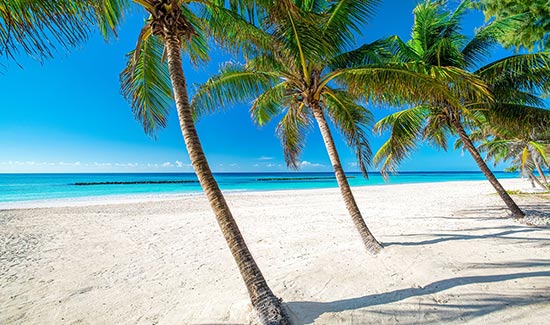10 amazing things about Barbados
You might have heard about the beaches, the food, the nightlife, the plantation great houses, the hospitality...
You might have heard about the beaches, the food, the nightlife, the plantation great houses, the hospitality, the Unesco World Heritage listed capital, but did you know these 10 amazing facts about Barbados?
- Barbados was originally christened Os Barbados by Portuguese explorer Pedro Campos. Back in 1536, when he first saw the island, it was covered by forests of the magnificent bearded fig trees that are indigenous to the island. The long aerial roots which hang from the tree’s branches made the trees look like they had beards, so he called the island the Portuguese equivalent of ‘the bearded ones’.
- Since Pedro graced our shores, though, things have changed quite a bit. For one, there are precious few bearded fig trees left. Now known as ‘the land of the flying fish’, Barbados has created a unique culinary tradition around a small fish that jumps out of the water and stays airborne for up to 45 seconds while gliding through the air as far as 50 meters. This clever little fish is not only a national symbol, but a key part of our delicious national dish, cou-cou and flying fish. Unfortunately, as it is a bit difficult to make, it’s quite rare to find it in restaurants, but at Virgo Villas, we’d be happy to arrange for your own personal chef to create it for you.
- Sticking to the theme of food, Barbados is famed as the birthplace of the grapefruit. This fruit, which has grown in popularity globally because of its health benefits and has even spawned a diet (the Grapefruit Diet), was born when two indigenous citrus fruits called the sweet orange and shaddock cross-pollinated all on their own in the beautiful Welchman Hall Gully in St. Thomas.
- With over 500 windmills, Barbados once had the second highest number of windmills per square mile in the world, second only to Holland. Once used in the production of sugar, many of these old windmills have now lost their sails but can still be seen dotted throughout our countryside. Some are preserved as part of old plantation estates, some stand alone, abandoned and disintegrating, while others have been converted into gorgeous homes. To see the only mill in working order left in Barbados and the Caribbean, visit the Morgan Lewis Windmill located in the scenic hills of the parish of St. Andrew.
- Staying with the sugar production theme, Barbados also holds the honour of being the birthplace of an important by-product of sugar: rum. Originally called Kill-Devil (what’s in a name?) by plantation slaves who first experimented with fermenting molasses to create their own alcohol in the1620s, the brew was eventually refined to create the first modern rums. Mount Gay distillery, founded in 1703, is believed to produce the oldest rum found anywhere in the world. Ask your Virgo Villas concierge to book a tour for you, and make sure you sample their world famous rum punch. Simply delicious!
- Barbados is the only country that the first president of the United States, George Washington, ever travelled to. In 1751, Washington visited Barbados at 19 and confessed that he was "perfectly ravished" and overwhelmed by "the beautiful prospects which on every side presented to our view”. For his compliments, we sent him on his way with a dose of smallpox which badly scarred his face. Not very nice of us, I know. You can visit the house where he stayed, aptly named George Washington House, located just outside of the capital Bridgetown.
- Though we are a Christian nation, below the surface we have our own system of beliefs and practices called Obeah. Obeah originated from a blend of various spiritual practices that our ancestors brought with them from Africa. There are no formalised rites as can be found with other African-derived practices like Santería in Cuba or Voodoo in Haiti, and Obeah has certainly waned in popularity in recent years. However, it does have its own “priests” and “priestesses” who many still believe have the power to heal, harm or charm and whose services can be hired by rich and poor alike.
- Barbados has its own Lord Nelson statue, and ours, which was erected in 1813 in Bridgetown's Trafalgar Square, predates the statue and square of the same name and fame in London by 30 years. Of course, our Trafalgar Square was renamed National Heroes Square in 1999, in honour of … um … more relevant national heroes of Barbados. Sorry, Lord Nelson.
- Contrary to popular belief, Barbados is not a part of the Caribbean archipelago, nor is it located in the Caribbean Sea. Rather, it lies on its own all lonesome out in the Atlantic Ocean, and along with islands like Trinidad & Tobago, the Bahamas and Bermuda, it’s considered to be a Western Atlantic island. Now you know, but don’t worry, we don’t press the point.
- According to the United Nations, Barbadians enjoy among the Caribbean’s highest life expectancy, and let me tell you, we know how to incentivise our populace to stay alive. In Barbados, if you live to 100, the post office just might immortalise your face on a stamp. 27 centenarians across the island have already had the honour. No wonder we have the second highest number of centenarians per capita after Japan.
Browse our selection of luxury villa rentals to start planning the perfect trip.





